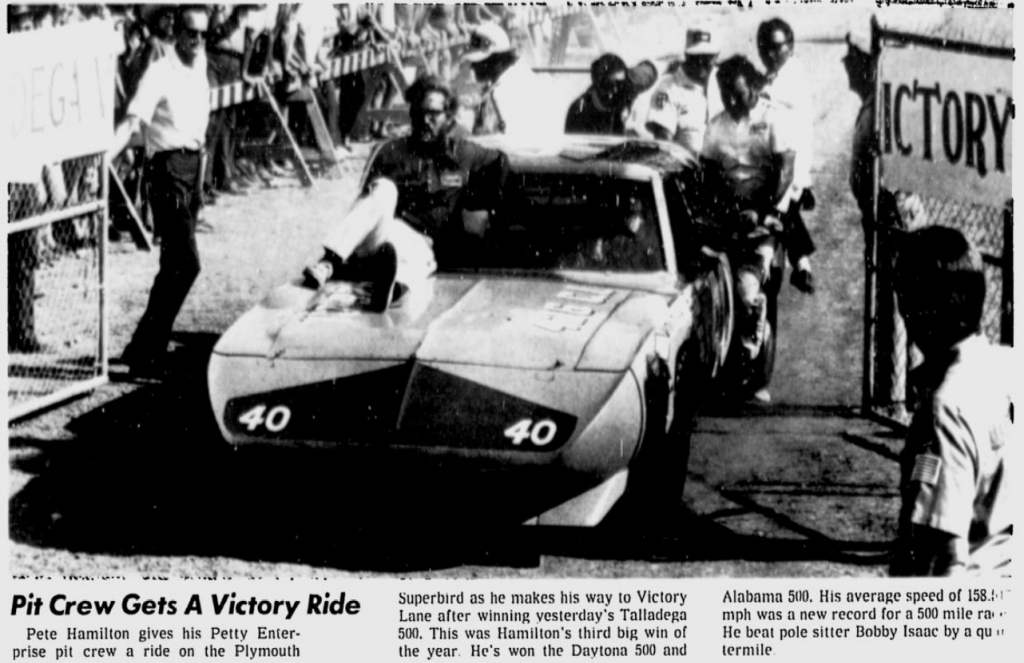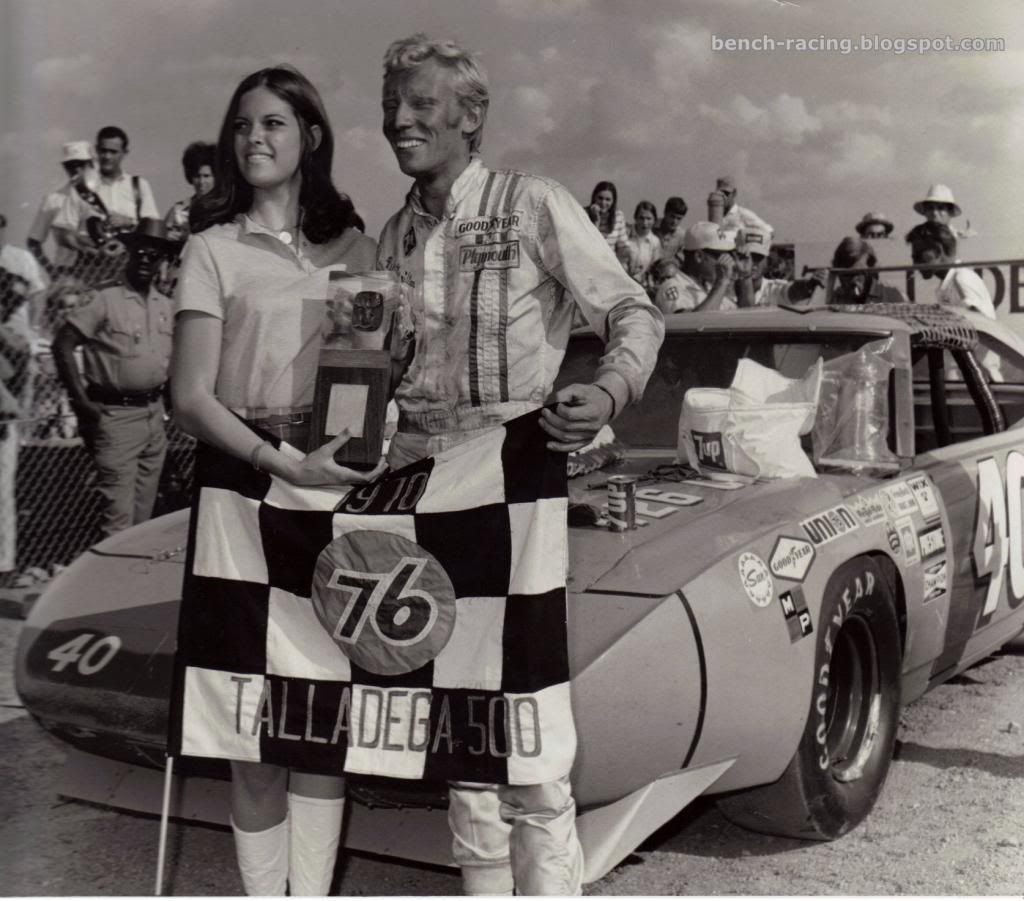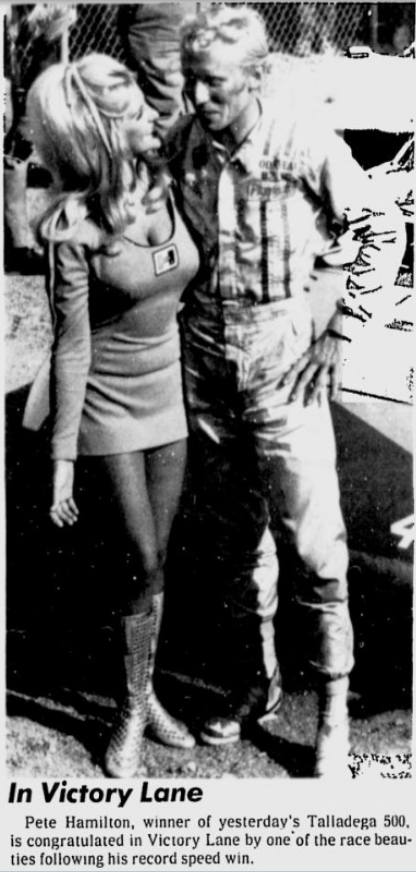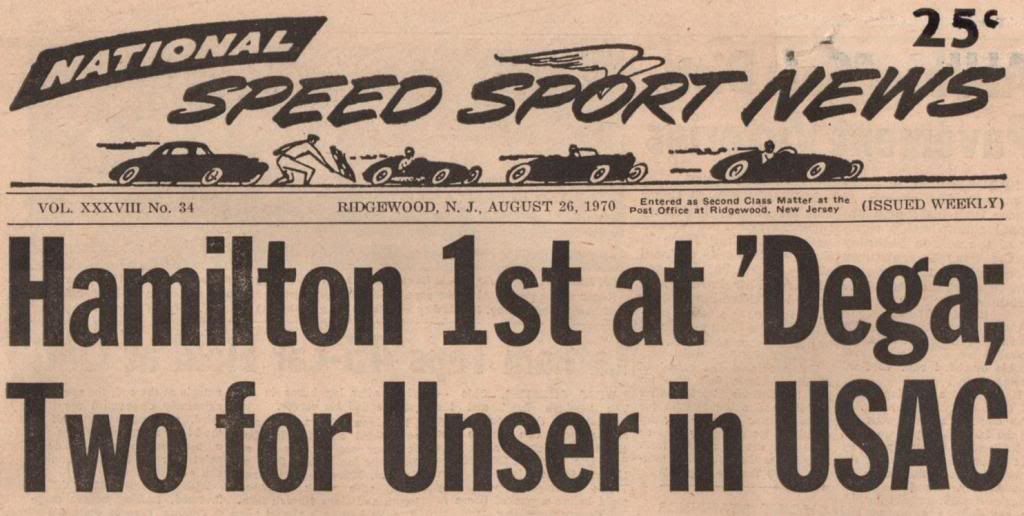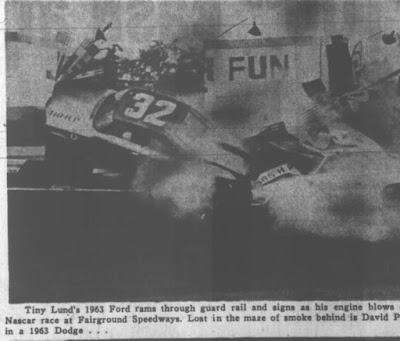August 29, 1954: In the only Grand National / Cup race in Kentucky until NASCAR went to Sparta's Kentucky Speedway in 2011, Lee Petty wins a 200-lap, 100-mile race on the half-mile, dirt Corbin Speedway.
As was the case with many early NASCAR races, details of the Corbin race are pretty sketchy. Future Petty driver, Jim Paschal, won the pole but ended up with a 19th place finish in the 21-car field. The rest of the starting lineup and lap leaders remain lost to history.
Hershel McGriff finished second. The seemingly ageless McGriff raced in the first Southern 500 at Darlington in 1950, drove a limited number of races for Petty Enterprises in 1973-74, and still made occasional starts as recently as a couple of years ago.
Eric Crawford wrote in his 2011 column for the
Louisville Courier Journal:
Only two drivers, Petty and McGriff, finished on the lead lap. Twelve of the 21 starters were running at the end. The third driver out of the race was Jim Paschal, who blew a gasket on the 29th lap after winning the pole at 65.789 mph.
Paul Jones of Corbin was a driver himself but didn't take part in the Grand National race that day. He ran in the preliminary race, won by Vermillion, then found an advantageous perch to watch from the pits, out of the overflow crowd in the grandstand.
“It was packed, I'll tell you,” Jones said. “Standing room only. Some of us drivers were acting as hosts, I guess you would call us, to the drivers who came in. And we were in awe of the big names. It was like a major league ball club coming to visit.
In an interview with the Lexington Herald-Leader that year, [flagman Eddie] Poynter called the race “the greatest thing since peppermint candy around here.”
No doubt it was. But it failed to garner a single mention in either of the state's largest newspapers, the Herald-Leader or The Courier-Journal.
In 2011, writer Mark Story
penned a solid story about the Corbin GN race - and was even able to include a few personal memories from those who participated in it. Key excerpts include:
When Junior, Smoke, the Busch brothers and their Sprint Cup contemporaries take the green flag Saturday night at Kentucky Speedway, it will not be the first "Cup" race run in the commonwealth.
The memory is largely lost to the mists of history, but NASCAR's highest series has run in Kentucky once before. On Aug. 29, 1954, a field of 21 drivers — including four that would one day be named among the 50 greatest NASCAR drivers of all time — lined up on the half-mile dirt track that was then the Corbin Speedway.
An hour and 35 minutes later, Lee Petty — yep, that Lee Petty, father of The King — made a dramatic pass of Hershel McGriff and guided his No. 42 Petty Engineering Chrysler to victory in the 200-lap race.
In 1954, legends-in-the-making like Lee Petty, Buck Baker and McGriff came to race in Kentucky yet the state's main newspapers didn't give them even one paragraph.
Had you purchased the Aug. 29, 1954, Courier-Journal, you would have read about the "youth, grit and late-warming putter" that led a new golfer, chap by the name of Palmer, to the National Amateur Championship.
From the same day's Lexington Herald you would've read — I kid you not — stories on trap shooting and pro wrestling.
There was not one word in either paper about the Grand National Series, as NASCAR's elite division was then known.
It was an Oldsmobile owned by Frank Christian that Hershel McGriff drove to second place.
Actually, McGriff says, there were two 1954 Oldsmobiles in use by his team that year: The one he raced and the one that pulled his race-car from track to track.
"That's why you didn't want to tear up the front of your (race) car," McGriff said in 2004. If you did, "you couldn't get it back on the tow-bar" to pull.
Before a suspension problem knocked Ralph Liguori's Dodge out of the Corbin race, the driver from New York City spent the days leading up to the event sleeping in a local Nash dealership.
"For the life of me, I can't remember the guy's name, but he was a real neat guy," Liguori
said in 2004. "Let me sleep and work right there."
In the current era, the business of NASCAR can overshadow the racing. Kentucky Speedway's decade-long pursuit of a Cup race has been one of the commonwealth's predominant sports stories of the 21st Century.
How Corbin, 1954, got a big-league race seems lost in the past.
The National Association for Stock Car Auto Racing sanctioned its first race in 1948. [Buz] McKim, the NASCAR historian, says that early in its existence the organization ran its top league in some unlikely locales.
"It raced once in North Dakota. Once in Oklahoma," McKim said in 2004. "It went to several tracks in the Midwest for one-shot deals."
There is not a specific answer, he says, to how NASCAR's big league came to Corbin.
We're left to the locals to fill in the blanks. Poynter, the race's flag man, said in 2004 that the connection that brought stock-car's big league to little Corbin was Bub King, a local driver.
King ran NASCAR events at both Daytona Beach and Darlington and the contacts he made eventually led to the Grand National Series coming to Kentucky, Poynter said.
"Bub just knew some NASCAR people," added Allen Dizney, the unofficial "historian" of Corbin, in 2004. "That was the connection."
The feel and flavor of Lee Petty's win in Corbin are also all but lost to the ages.
NASCAR can give you the race results. Of the 21 drivers, only Petty and McGriff finished on the lead lap. Jim Paschal laid down a 65.789 mph qualifying lap to claim the pole. The average speed of the race was a
scalding 63.08 mph.
The four drivers in the field — Petty, McGriff, Buck Baker and Herb Thomas — who would go on to be named among the 50 Greatest NASCAR drivers of all time finished 1-2-3-4 in Corbin.
Petty earned a cool $1,000 for winning at Corbin; McGriff got $650 for coming in second. Everyone who finished below 10th got $25.
In 2004, I tracked down two drivers who drove in the race.
I asked Liguori what he remembers about the race in Corbin.
"I think I had one of my better days," he says.
You finished 16th of 21.
"I guess I had one of my bad days," he said, laughing.
Next, I called McGriff, a remarkable racing figure who raced as a driver well into his 70s.
What do your remember about Corbin?
Pause."I seem to remember the name Corbin," he said. "Where is it exactly?"
Southeast Kentucky.
"Oh."
Remember anything at all about the race?
"Well ... not really. It's been 50 years, that's a lot of races ago ..."
You finished second to Lee Petty.
"Then I finished behind a real good driver."
Kentucky driver Bub King - who apparently knew whose hand to shake, whose number to call, and whose knee to bow to land the one and only Grand National / Cup race in the commonwealth until the series debuted at Kentucky Speedway in 2011.
Tim Branstetter
Tim Branstetter
Tim Branstetter
Tim Branstetter included these memories
in an article he wrote for Corbin's Times Tribune in July 2011:
On Aug.
29, 1954, 20 drivers chased Lee Petty around the half-mile dirt track at
Corbin Speedway for 200 laps. Corbin resident Allen Dizney was parked
in the infield with his jeep that was painted up and ready to clean up
any wrecks.
“It was an unusual service truck,” Dizney said. “It was a 4-wheel drive jeep and it was all fixed up with lights on it.”
That jeep didn’t get used much during the NASCAR race.
“They never really wrecked,” Dizney said. “They weren’t going fast enough to tear up cars. They only ran about 60 mph.”
Dizney didn’t have to do much work during the race, but he wasn’t getting paid either.
“We didn’t get paid nothing,” he said. “It was a volunteer thing. Just a
city thing. I never made a dime, but I enjoyed it very much.”
Bub King was a NASCAR driver from Corbin and was the biggest reason that Corbin was able to host the event.
“Bub worked at it and got it done,” Dizney said. “We were tickled to
death with it. Everyone was excited to have a NASCAR race.”
When asked if he was a friend of King’s, Dizney replied, “He was a
friend of everybody. He was just a local boy like the rest of us. He was
in the service and then got into racing.”
Dizney was a Petty fan, but he made it clear who he was cheering for during the race at Corbin Speedway.
“I was hollering for Bub (King) and Dick (Vermillion), he said. “They
were local boys. I liked Petty, but that was on a national scale.”
Petty ended up winning the race, while Vermillion finished in 14th place and King finished in 18th place.
Petty won the race by passing Hershel McGriff on the last lap and Dizney decided to congratulate him after the race.
“I introduced myself to Petty after the race,” he said. “He was real
cordial and very nice to me. He was checking the oil in his car.”
While tonight’s race at Kentucky Speedway will be exciting for the fans
and leave its mark on NASCAR history, Dizney didn’t think anything
about making history when he watched as Petty took home $1,000 for
winning the first NASCAR race in Kentucky.
“It was just a race,” Dizney said. “It was just something that
happened. We wasn’t trying to make history. At the time it was just an
automobile race. It was just a race with some guys that we had read
about in the paper.”
McGriff claimed $650 for second place, while Buck Baker took $450 for
third and Herb Thomas won $350 for fourth place. Vermillion and King won
$25 each. - See more at:
http://thetimestribune.com/sports/x614902764/Corbin-hosted-NASCAR-first/#sthash.L31UOHGE.dpuf
Corbin resident Allen Dizney was parked in the infield with his jeep that was painted up and ready to clean up any wrecks.
That jeep didn’t get used much during the NASCAR race.
“They never really wrecked,” Dizney said. “They weren’t going fast enough to tear up cars. They only ran about 60 mph.”
Dizney didn’t have to do much work during the race, but he wasn’t getting paid either.
“We didn’t get paid nothing,” he said. “It was a volunteer thing. Just a city thing. I never made a dime, but I enjoyed it very much.”
Dizney was a Petty fan, but he made it clear who he was cheering for during the race at Corbin Speedway.
“I was hollering for Bub (King) and Dick (Vermillion), he said. “They were local boys. I liked Petty, but that was on a national scale.”
Petty ended up winning the race, while Vermillion finished in 14th place and King finished in 18th place.
Petty won the race by passing Hershel McGriff on the last lap and Dizney decided to congratulate him after the race.
“I introduced myself to Petty after the race,” he said. “He was real cordial and very nice to me. He was checking the oil in his car.”
“It was just a race,” Dizney said. “It was just something that happened. We wasn’t trying to make history. At the time it was just an automobile race. It was just a race with some guys that we had read about in the paper.”
I'm unsure why essentially all media outlets opted not to cover Corbin's GN race. Perhaps it was because the series only made the one stop and the track had no year-to-year opportunity to build momentum. Perhaps the state was preoccupied with its other passions such as horses and hoops. Or perhaps its because over time, Corbin became better known as the original home of Colonel Harlan Sanders and his Kentucky Fried Chicken vs. Lee Petty's victory.
Sometime after the 1954 race on the half-mile, dirt track, Corbin was re-designed into a paved, quarter-mile track. Though its gone through some tough stretches, the Eastern Kentucky track still operates today.
Information posted by the track's news director and arguably its greatest evangelist of its history, John "IndyBigJohn" Potts, can be read on the track's
website and
Facebook page.
TMC











